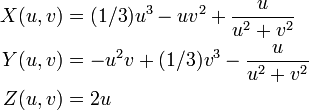Richmond surface
From Wikipedia, the free encyclopedia

Richmond surface for m=2.
In differential geometry, a Richmond surface is a minimal surface first described by Herbert William Richmond in 1904. [1] It is a family of surfaces with one planar end and one Enneper surface-like self-intersecting end.
It has Weierstrass–Enneper parameterization  . This allows a parametrization based on a complex parameter as
. This allows a parametrization based on a complex parameter as
The associate family of the surface is just the surface rotated around the z-axis.
Taking m = 2 a real parametric expression becomes:[2]
References
This article is issued from Wikipedia. The text is available under the Creative Commons Attribution/Share Alike; additional terms may apply for the media files.
![{\begin{aligned}X(z)&=\Re [(-1/2z)-z^{{2m+1}}/(4m+2)]\\Y(z)&=\Re [(-i/2z)+iz^{{2m+1}}/(4m+2)]\\Z(z)&=\Re [z^{n}/n]\end{aligned}}](/2014-wikipedia_en_all_02_2014/I/media/c/7/3/8/c73888e95f28f488ef95f2f7ae4800d4.png)
